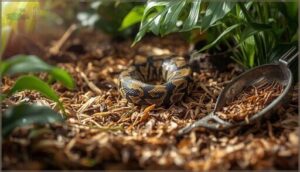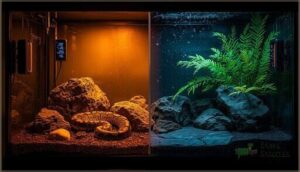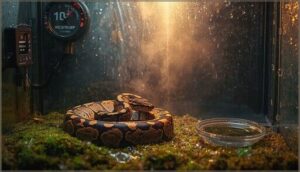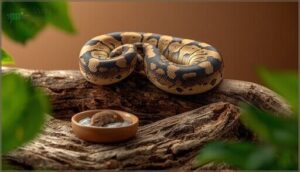This site is supported by our readers. We may earn a commission, at no cost to you, if you purchase through links.

Your new ball python just arrived, and suddenly you’re staring at a glass tank wondering if you’ve made a terrible mistake. Don’t worry—you’re not alone. Most new python owners feel overwhelmed at first, but here’s the truth: python snake care and housing isn’t rocket science.
Once you nail down the basics of temperature, humidity, and feeding, you’ll wonder why you ever stressed. The key is setting up their environment right from day one. Get the enclosure dialed in, and your snake will thrive for decades.
This guide breaks down exactly what your python needs to stay healthy, from choosing the right tank size to mastering feeding schedules that prevent common problems.
Table Of Contents
Key Takeaways
- Your ball python needs a properly sized enclosure (starting at 10 gallons for hatchlings, up to 40 gallons for adults) with secure locking lids, since these snakes are natural escape artists who will find any weak point.
- Temperature and humidity control are non-negotiable—maintain a gradient of 90-95°F on the warm side and 78-80°F on the cool side, with 50-60% humidity throughout the enclosure to prevent shedding problems and respiratory issues.
- Feed your python frozen-thawed prey (never live) that’s 1 to 1.25 times the snake’s width, adjusting frequency from weekly for hatchlings to every 3-4 weeks for adults, and always wait 48 hours after feeding before handling.
- Daily spot cleaning and weekly deep disinfection of the enclosure prevents disease, while watching for warning signs like respiratory mucus, appetite loss lasting over a week, or lethargy means you need a reptile vet fast.
Choosing The Right Ball Python Enclosure
Picking the right home for your ball python is the first big step. Each type of enclosure has its own benefits and challenges. Let’s break down what you should know before you choose.
Minimum Enclosure Size by Age
Regarding ball python housing, size really does matter. Hatchling care means starting with a cozy 10-gallon tank. Juvenile housing calls for at least 36 inches of space. Subadult enclosures should be even bigger, matching snake growth. Adults need a 4-foot-long habitat.
Meeting the minimum enclosure size helps your python thrive at every stage. Proper enclosure size guidelines are essential for ball python care.
Secure Lids and Escape Prevention
Ball pythons are born escape artists. Even with the right enclosure size, lid security is a must. Vet recommendations point to strong locks and proper fasteners—not just makeshift fixes. Material durability matters too, since loose lids often lead to escapes. Watching for common escape trends keeps your snake safe and you out of panic mode. To prevent accidental openings, using wire locks can be beneficial.
- Choose metal mesh or sliding doors with locks
- Use at least four sturdy fasteners on aquarium lids
- Avoid plastic clips or tape—these often fail
- Inspect lid security every season for wear and tear
Best Enclosure Materials and Designs
Once you’ve secured the lid, picking the right enclosure material is key. Most go for PVC enclosures—they’re easy to clean, boost humidity control, and last for decades. Wood alternatives work if sealed, but need upkeep. Modular systems grow with your snake’s enclosure size.
Bioactive designs with natural substrate can turn your habitat setup into a living ecosystem, making temperature and humidity stable.
Setting Up The Ideal Habitat
Getting your ball python’s habitat just right makes a big difference in their health and happiness. There are a few key choices you’ll need to make before you settle your snake in. Let’s walk through the basics so you know what to expect.
Substrate Options and Recommendations
Ever feel lost picking substrate for your snake enclosure? You’re not alone. For ball pythons, cypress mulch and coconut fiber keep substrate humidity in a healthy range—no drying out.
Bioactive benefits shine with brands like ReptiChip or The Bio Dude.
Cleaning frequency matters too: deep clean monthly, spot clean weekly. Watch for impaction risks with loose or dusty options.
Adding Hide Boxes and Decor
Security is the name of the game for your python. Hide boxes matter—a lot. Choose from sturdy plastic caves, moss hides, or even DIY options to give your snake hiding places it loves.
Place hides on both warm and cool sides, tucked into enclosure decorations. Mix in branches or faux plants for enrichment elements and microclimate maintenance. Size and snugness matter.
Creating a Temperature Gradient
When creating a temperature gradient, you set your snake up for natural thermoregulation.
Here are the steps to achieve this:
- Place heat sources on one end for gradient creation.
- Keep the cool side shaded and comfortable.
- Use multiple thermometers for precision.
- Monitor temperature control day and night.
- Tweak heating as seasons change—your python’s health depends on stable, safe temperatures.
Maintaining Proper Humidity Levels
When you keep a ball python, maintaining proper humidity levels is key. Aim for 50–60% humidity using moisture-rich substrate selection, careful misting techniques, and a good hygrometer for humidity monitoring.
Spot issues early—too low causes shedding issues, too high can hurt your snake’s health. Adjust enclosure humidity levels quickly, and you’ll avoid most problems these snakes face in captivity.
Heating, Lighting, and Water Needs
Keeping your ball python comfortable means nailing the basics: heat, humidity, and water. Each piece plays a big part in your snake’s health. Let’s go over the essentials you’ll need for the perfect setup.
Ideal Temperature Ranges
Imagine your python’s enclosure as its own private climate zone. Basking Temperatures should land between 90 and 95°F, while Hide Temperatures need a steady 78 to 90°F split. Maintain Ambient Ranges from 80 to 85°F, and let Nighttime Temps drop no lower than 75°F.
This Thermal Gradient helps your snake thermoregulate—just like sunbathing or chilling in the shade!
Heating Equipment and Thermostat Use
Why risk a toasty disaster? Getting Heating Equipment Safety right is step one for happy snakes. Use halogen bulbs as your main heat source—pick wattage based on your enclosure’s size. Place the thermostat probe under the heat mat (never inside), and use a quality thermostat for reliable Temperature Gradient Control. It all keeps temperature steady and your ball python safe.
- Choose the right heat source and wattage.
- Always connect heating to a thermostat.
- Position thermostat probes correctly for accuracy.
- Check temperature gradient daily for safety.
Humidity Monitoring Tools
You need accurate digital hygrometers to track humidity levels inside your ball python’s enclosure. Pick models with probes—they let you check humidity sensors at different spots, especially inside hides. Aim for 50-60% humidity at all times.
Place probes mid-height on the cool side for the best readings. Check calibration methods every six months. Temperature humidity monitoring systems keep your snake healthy and shedding smoothly.
Providing Fresh Water and Large Dishes
Your ball python needs constant access to clean water in a large, sturdy bowl. Choose a dish at least 8 inches wide—big enough for soaking during sheds. Change the water daily to prevent bacteria.
Use non-porous materials like plastic or stainless steel for easy cleaning. Position the bowl away from heat sources to reduce evaporation and maintain humidity.
Feeding Your Ball Python Safely
Feeding your ball python the right way keeps them healthy and stress-free. You’ll want to know what to feed, how often, and the safest methods to avoid problems.
Here’s everything you need to get feeding time right from day one.
Recommended Diet and Prey Size
Your ball python needs whole prey like frozen-thawed rats or mice. Choose prey size that’s about 1 to 1.25 times your snake’s widest part—roughly 10-15% of its body weight.
Hatchlings start with pinkie rats around 5-12 grams. Adults handle large rats up to 275 grams.
Proper prey size prevents regurgitation and promotes healthy snake nutrition throughout their life.
Feeding Frequency by Age
Once you’ve picked the right prey size, timing matters just as much. Your feeding schedule changes as your snake grows.
Here’s how often you should feed at each stage:
- Hatchling Feeding: Offer food every 5-7 days to support rapid early growth
- Juvenile Schedules: Feed every 7-10 days as growth slows after the first year
- Sub-Adult Portions: Space meals 14-21 days apart once your python reaches 700 grams
Adult fasting becomes normal—many adults eat just once every 3-4 weeks. Breeding females need more frequent meals during reproductive periods.
How to Thaw and Offer Frozen Prey
Frozen prey thawing starts with patience. Place frozen rodents in a sealed container in the fridge overnight, or submerge them in cold water for 30-60 minutes, changing water every half hour.
Warm the thawed prey in 100°F water for 10-20 minutes before offering. Never microwave—it creates dangerous hot spots.
Handle with gloves to prevent contamination and preserve your snake’s feeding response.
Safe Feeding Techniques and Tips
Using feeding tools protects both you and your snake. Here’s how to feed your ball python safely:
- Use long stainless steel tongs to prevent accidental bites during feeding.
- Dangle prey gently to trigger natural hunting instincts.
- Feed during nighttime hours when your snake is most active.
- Remove uneaten food within 24 hours to maintain proper hygiene.
- Skip handling for 48 hours after feeding to prevent regurgitation.
Maintaining Health and Safe Handling
Keeping your ball python healthy means staying on top of enclosure cleanliness and watching for warning signs. You’ll also need to know how to handle your snake without stressing it out.
Let’s cover the basics of maintenance, spotting problems early, and knowing when it’s time to call a vet.
Cleaning and Disinfecting The Enclosure
Keeping your snake’s home clean isn’t optional—it’s disease prevention in action. Spot clean waste daily, then deep clean weekly using a 3% bleach solution or F10SC disinfectant. Replace substrate every 2–4 weeks to stop pathogens from building up.
Scrub all furnishings with hot soapy water, rinse thoroughly, and let everything dry completely. These sanitation protocols protect your python’s health long-term.
Recognizing Signs of Illness or Stress
Your python’s behavior tells you everything—you just need to watch. Respiratory issues like mucus bubbles or wheezing affect 30% of sick snakes. Appetite loss lasting over a month signals trouble in 85% of cases.
Watch for these stress signs:
- Lethargy or refusing to move when handled
- Defensive postures like constant hissing
- Skin problems including stuck shed or red scales
- Sudden weight loss or repeated regurgitation
Contact a reptile veterinarian if behavioral changes persist.
Proper Handling Techniques
Slow and gentle wins every time with snake handling. Support your python’s entire body to prevent injury. Wait 48 hours post-feeding before handling to avoid regurgitation. Handle 1-2 times weekly for best results.
Watch for defensive behaviors like tight balling or hissing—stress indicators that mean back off. Lift from underneath, never grab the head. Guide movements calmly. Your snake behavior improves with consistent, patient handling techniques and proper stress responses recognition.
When to Contact a Reptile Veterinarian
Your ball python needs a reptile veterinarian right away if you spot Emergency Symptoms like these:
- Open-mouth breathing, wheezing, or discharge from nose or mouth
- Three missed meals with weight loss or repeated regurgitation
- Swelling, tissue prolapse, seizures, or poor coordination
Annual Check-ups catch problems early. Watch for Behavioral Changes like excessive hiding or lethargy—signs pointing to Snake health issues needing professional Preventative Care.
Frequently Asked Questions (FAQs)
Can ball pythons recognize their owners over time?
Research shows ball pythons don’t recognize owners like mammals do. They can’t pass olfactory studies testing self-recognition.
However, consistent handling leads to behavioral adaptation—your snake may seem calmer through cognitive learning, not true bonding.
How often should I replace my pythons substrate?
You’ll need to replace substrate every 2–3 months with regular spot cleaning. Bioactive options last longer, while aspen needs monthly changes.
Humidity control and cleaning schedules directly impact replacement frequency and costs.
Do ball pythons need UVB lighting or supplements?
You won’t believe this—your ball python doesn’t absolutely need UVB lighting or supplements. Whole prey provides vitamin D3 and calcium naturally.
UVB benefits include immune support, visual perception, and cryptic basking behavior, but it’s optional.
How do I safely transport my ball python?
Use a secure container with proper ventilation for transport containers. Add a pillowcase for snake wrapping to reduce travel stress.
Monitor humidity control and temperature. Focus on escape prevention and pet safety throughout the journey.
Conclusion
Ball pythons can live 30+ years with proper care—that’s three decades of companionship waiting for you. Now that you understand python snake care and housing fundamentals, you’re equipped to give your snake exactly what it needs.
Set up that enclosure with confidence. Monitor those temps and humidity levels. Stick to a consistent feeding schedule. Your python doesn’t need flawlessness—just commitment to the basics. You’ve got this, and your snake will thrive because of it.
- http://www.reptifiles.com/
- https://reptifiles.com/ball-python-care-guide/ball-python-terrarium-size-lighting/
- https://www.wilbanksreptiles.com/blogs/ideal-tank-size-for-healthy-ball-pythons/what-is-the-recommended-tank-size-for-a-ball-python?srsltid=AfmBOopEZDvAoalkqJJ6rSJpZNVd4QSvoLXQ_6EouS3JhZWOUSGCbCNf
- https://www.petmd.com/reptile/ball-python-care-sheet
- https://www.reddit.com/r/ballpython/comments/jt34fv/a_psa_about_preventing_escapes/













